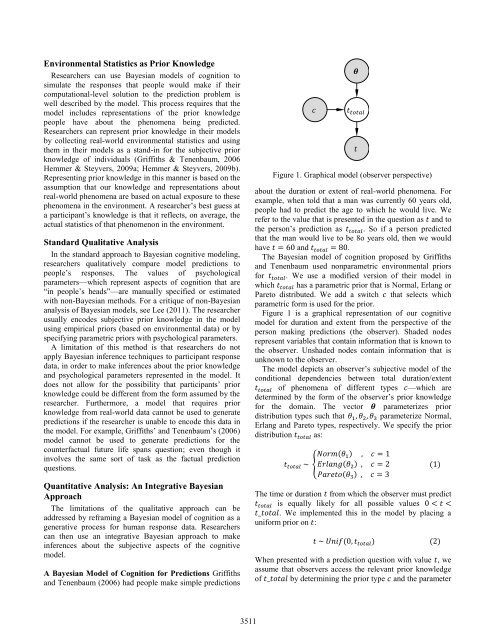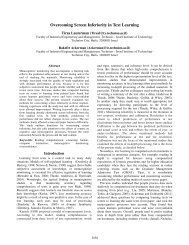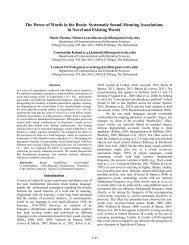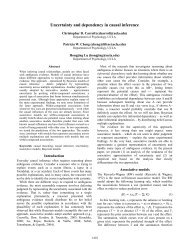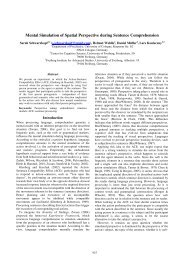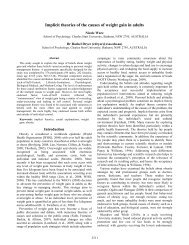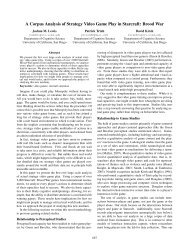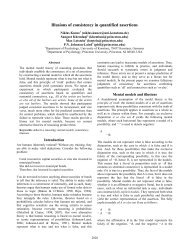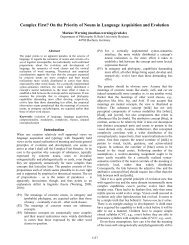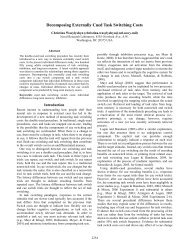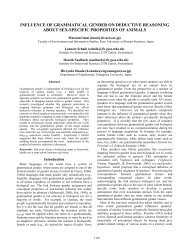Inferring Subjective Prior Knowledge: An ... - MindModeling.org
Inferring Subjective Prior Knowledge: An ... - MindModeling.org
Inferring Subjective Prior Knowledge: An ... - MindModeling.org
Create successful ePaper yourself
Turn your PDF publications into a flip-book with our unique Google optimized e-Paper software.
Environmental Statistics as <strong>Prior</strong> <strong>Knowledge</strong><br />
Researchers can use Bayesian models of cognition to<br />
simulate the responses that people would make if their<br />
computational-level solution to the prediction problem is<br />
well described by the model. This process requires that the<br />
model includes representations of the prior knowledge<br />
people have about the phenomena being predicted.<br />
Researchers can represent prior knowledge in their models<br />
by collecting real-world environmental statistics and using<br />
them in their models as a stand-in for the subjective prior<br />
knowledge of individuals (Griffiths & Tenenbaum, 2006<br />
Hemmer & Steyvers, 2009a; Hemmer & Steyvers, 2009b).<br />
Representing prior knowledge in this manner is based on the<br />
assumption that our knowledge and representations about<br />
real-world phenomena are based on actual exposure to these<br />
phenomena in the environment. A researcher’s best guess at<br />
a participant’s knowledge is that it reflects, on average, the<br />
actual statistics of that phenomenon in the environment.<br />
Standard Qualitative <strong>An</strong>alysis<br />
In the standard approach to Bayesian cognitive modeling,<br />
researchers qualitatively compare model predictions to<br />
people’s responses. The values of psychological<br />
parameters—which represent aspects of cognition that are<br />
“in people’s heads”—are manually specified or estimated<br />
with non-Bayesian methods. For a critique of non-Bayesian<br />
analysis of Bayesian models, see Lee (2011). The researcher<br />
usually encodes subjective prior knowledge in the model<br />
using empirical priors (based on environmental data) or by<br />
specifying parametric priors with psychological parameters.<br />
A limitation of this method is that researchers do not<br />
apply Bayesian inference techniques to participant response<br />
data, in order to make inferences about the prior knowledge<br />
and psychological parameters represented in the model. It<br />
does not allow for the possibility that participants’ prior<br />
knowledge could be different from the form assumed by the<br />
researcher. Furthermore, a model that requires prior<br />
knowledge from real-world data cannot be used to generate<br />
predictions if the researcher is unable to encode this data in<br />
the model. For example, Griffiths’ and Tenenbaum’s (2006)<br />
model cannot be used to generate predictions for the<br />
counterfactual future life spans question; even though it<br />
involves the same sort of task as the factual prediction<br />
questions.<br />
Quantitative <strong>An</strong>alysis: <strong>An</strong> Integrative Bayesian<br />
Approach<br />
The limitations of the qualitative approach can be<br />
addressed by reframing a Bayesian model of cognition as a<br />
generative process for human response data. Researchers<br />
can then use an integrative Bayesian approach to make<br />
inferences about the subjective aspects of the cognitive<br />
model.<br />
A Bayesian Model of Cognition for Predictions Griffiths<br />
and Tenenbaum (2006) had people make simple predictions<br />
Figure 1. Graphical model (observer perspective)<br />
about the duration or extent of real-world phenomena. For<br />
example, when told that a man was currently 60 years old,<br />
people had to predict the age to which he would live. We<br />
refer to the value that is presented in the question as and to<br />
the person’s prediction as . So if a person predicted<br />
that the man would live to be 8o years old, then we would<br />
have and .<br />
The Bayesian model of cognition proposed by Griffiths<br />
and Tenenbaum used nonparametric environmental priors<br />
for . We use a modified version of their model in<br />
which has a parametric prior that is Normal, Erlang or<br />
Pareto distributed. We add a switch that selects which<br />
parametric form is used for the prior.<br />
Figure 1 is a graphical representation of our cognitive<br />
model for duration and extent from the perspective of the<br />
person making predictions (the observer). Shaded nodes<br />
represent variables that contain information that is known to<br />
the observer. Unshaded nodes contain information that is<br />
unknown to the observer.<br />
The model depicts an observer’s subjective model of the<br />
conditional dependencies between total duration/extent<br />
of phenomena of different types —which are<br />
determined by the form of the observer’s prior knowledge<br />
for the domain. The vector parameterizes prior<br />
distribution types such that parameterize Normal,<br />
Erlang and Pareto types, respectively. We specify the prior<br />
distribution as:<br />
{<br />
( )<br />
( )<br />
( )<br />
(1)<br />
The time or duration from which the observer must predict<br />
is equally likely for all possible values<br />
. We implemented this in the model by placing a<br />
uniform prior on :<br />
( ) (2)<br />
When presented with a prediction question with value , we<br />
assume that observers access the relevant prior knowledge<br />
of by determining the prior type and the parameter<br />
3511


